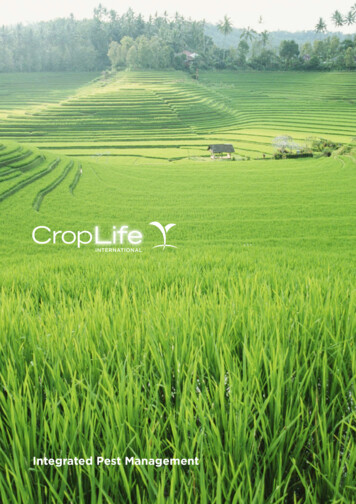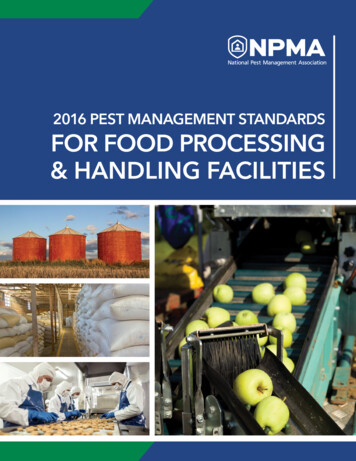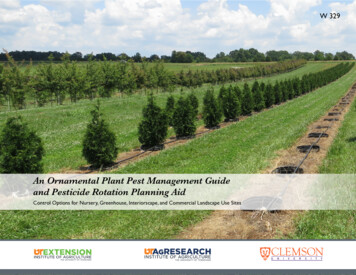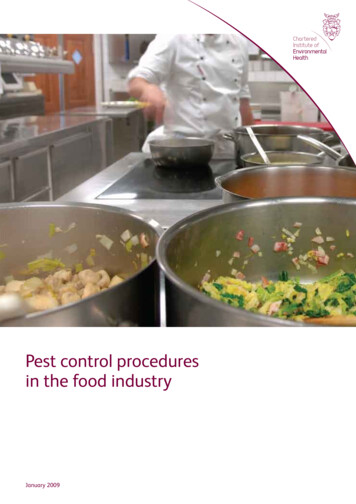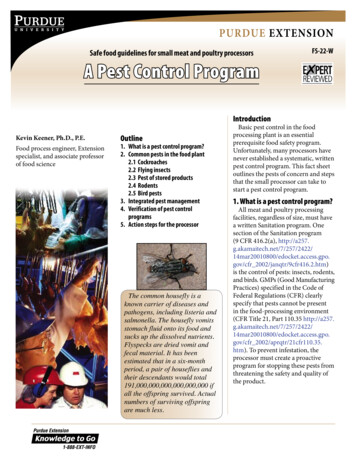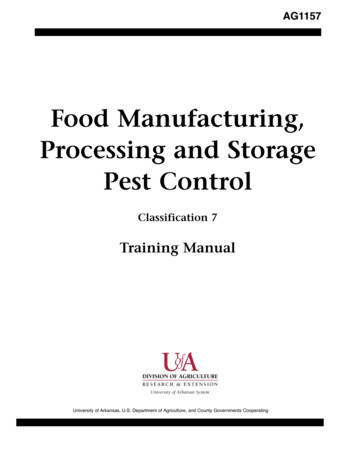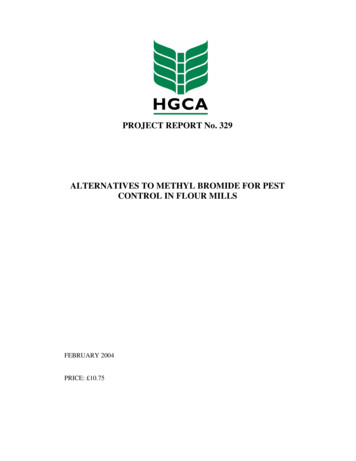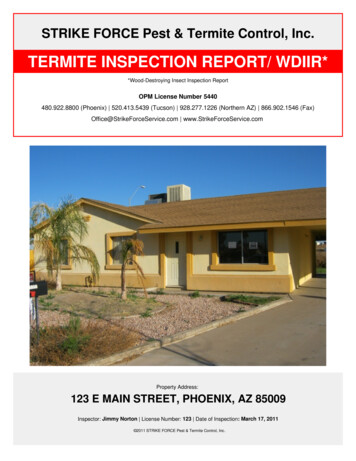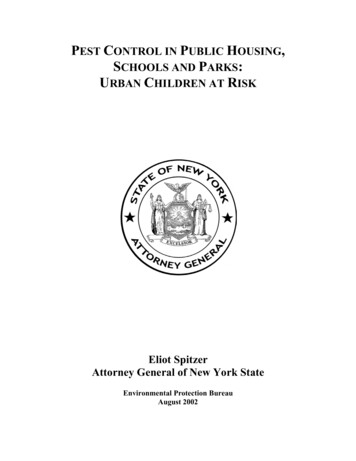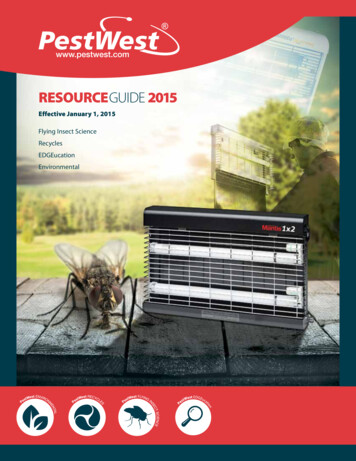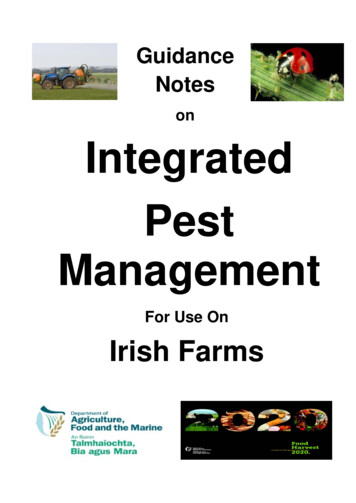
Transcription
GuidanceNotesonIntegratedPestManagementFor Use OnIrish Farms
ContentsFrequently Asked Questions . 1General principles of integrated pest management . 2IPM Record Sheet . 31. The prevention and/or suppression of harmful organisms . 32. Monitoring of harmful organisms . 83. Application of plant protection measures . 104. Sustainable biological, physical or other non-chemical methods . 115. The pesticides applied shall be as specific as possible for the target pest. . 146.Use of pesticides at necessary levels . 187. The prevention and/or suppression of harmful organisms . 198. Success of the applied crop protection measures . 21Appendices . 23Application of Integrated Pest Management (IPM) at user level . 23Pesticide Application Record . 25
Frequently Asked QuestionsWhat is Integrated Pest Management (IPM)?As defined in the sustainable use of pesticides directive (Directive 2009/128/EC), ‘integrated pestmanagement’ means careful consideration of all available plant protection methods and subsequentintegration of appropriate measures that discourage the development of populations of harmfulorganisms and keep the use of plant protection products and other forms of intervention to levels thatare economically and ecologically justified and reduce or minimise risks to human health and theenvironment. ‘Integrated pest management’ emphasises the growth of a healthy crop with the leastpossible disruption to agro-ecosystems and encourages natural pest control mechanisms;In more simple terms:"IPM is a sustainable approach to managing pests by combining biological, cultural, physical andchemical tools in a way that minimizes economic, health, and environmental risks.“(North Dakota State University)Who should use IPM?All professional users of Plant Protection Products (PPPs) must operate to the “general principles” ofstIPM from January 1 2014. Professional users of PPPs are encouraged to adopt crop specific orsector specific guidelines for the production of certain products.What is a professional user of PPPs?As defined in the sustainable use of pesticides directive (Directive 2009/128/EC),, a ‘professionaluser’ means any person who uses pesticides in the course of their professional activities, includingoperators, technicians, employers and self-employed people, both in the farming and other sectors;So, in effect all users of PPPs, except those who merely use PPPs in an amateur context such asprivate garden use.What are the general principles of IPM?The general principles of IPM are a set of guiding bases which were defined in the sustainable use ofpesticides directive. They are designed to help end users of PPPs to reduce reliance on PPP useand to reduce the risks associated with such use. They are easy to understand and easy toimplement.What IPM records will farmers/growers be required to maintain?Records proving implementation of IPM must be maintained by all farmers/growers. If using a PPPthe reason for using the PPP should be recorded in the user’s Pesticide Application Record sheet(see Appendices). A “tick box” worksheet has also been designed to enable farmers/growersdemonstrate how they are adopting the general principles of IPM (see Appendices).There are noexemptions from the requirement to maintain these records.What happens if I do not maintain records?The marketing and use of PPPs is primarily covered by the approval regulation (Regulation (EC) No1107/2009) and the sustainable use of pesticides directive (Directive 2009/128/EC). Only Regulation(EC) No 1107/2009 is covered under Statutory Management Requirement 10 (SMR10).Therefore, if records of PPP use and rationale for their use are not provided, a percentagedisallowance for Single Payment recipients will ensue, with the possibility of a fixed payment notice of 250. If IPM records proving implementation of the general principle of IPM are not maintained, afixed payment notice of 250 will be considered.1
General principles of integrated pest management (excerpt from Annex Ito Directive 2009/128/EC)1. The prevention and/or suppression of harmful organisms should be achieved or supported amongother options especially by:— crop rotation,— use of adequate cultivation techniques (e.g. stale seedbed technique, sowing dates and densities,under-sowing, conservation tillage, pruning and direct sowing),— use, where appropriate, of resistant/tolerant cultivars and standard/certified seed and plantingmaterial,— use of balanced fertilisation, liming and irrigation/drainage practices,— preventing the spreading of harmful organisms by hygiene measures (e.g. by regular cleansing ofmachinery and equipment),— protection and enhancement of important beneficial organisms, e.g. by adequate plant protectionmeasures or the utilisation of ecological infrastructures inside and outside production sites.2. Harmful organisms must be monitored by adequate methods and tools, where available. Suchadequate tools should include observations in the field as well as scientifically sound warning,forecasting and early diagnosis systems, where feasible, as well as the use of advice fromprofessionally qualified advisors.3. Based on the results of the monitoring the professional user has to decide whether and when toapply plant protection measures. Robust and scientifically sound threshold values are essentialcomponents for decision making. For harmful organisms threshold levels defined for the region,specific areas, crops and particular climatic conditions must be taken into account before treatments,where feasible.4. Sustainable biological, physical and other non-chemical methods must be preferred to chemicalmethods if they provide satisfactory pest control.5. The pesticides applied shall be as specific as possible for the target and shall have the least sideeffects on human health, non-target organisms and the environment.6. The professional user should keep the use of pesticides and other forms of intervention to levelsthat are necessary, e.g. by reduced doses, reduced application frequency or partial applications,considering that the level of risk in vegetation is acceptable and they do not increase the risk fordevelopment of resistance in populations of harmful organisms.7. Where the risk of resistance against a plant protection measure is known and where the level ofharmful organisms requires repeated application of pesticides to the crops, available anti-resistancestrategies should be applied to maintain the effectiveness of the products. This may include the use ofmultiple pesticides with different modes of action.8. Based on the records on the use of pesticides and on the monitoring of harmful organisms theprofessional user should check the success of the applied plant protection measures.2
IPM Record SheetWhen completing the IPM record sheet, the end user should tick the options that are most appropriateto their holding. The IPM record sheet is not exhaustive and allows the end user to add other options.Background and brief description1. The prevention and/or suppression of harmful organismsCrop rotationSterile seedbed techniqueClean machinery and equipmentClean potato boxes/growing trays etc.Nutrient management programmeIrrigation (applied to schedule)Soil testing (pH, nutrients, OM)Protect beneficial organismsCertified seedFull inversion tillage (plough)Choose disease resistant varietiesMinimum cultivationManagement of crop residuesSoil structure & compactionUse of optimal sowing dateClean crop storage areasOther (please specify)Sterile seed bed techniqueThe sterile seed bed technique involves cultivating the soil, and then leaving it for a period until aninitial flush of weeds has germinated. The grower will then either lightly cultivate or use a totalherbicide to destroy the weed cover, before the desired crop is planted/sown.Crop RotationCrop rotation involves the successive plantingof different crops on the same land to improvesoil fertility and help control troublesomeinsects, diseases and weeds.Whilst the continuous cropping of some cropscan be successfully done without any majoragronomic disadvantages e.g., spring barley, Itis generally good practice to follow somedegree of crop rotation. Continuous croppingof certain crops can result in higher input costs,lower yields, higher pest pressure andincreased likelihood of resistance.Forexample, 2 or 3 successive crops of winterwheat will yield significantly lower than growinga winter wheat crop after a broadleaved breakcrop, due largely to effects of the “take all”fungus (Gaeumannomyces graminis).3
Cleaning Machinery and equipmentMachinery can often be responsible for the transport of pests from fieldto field or farm to farm. Examples of this are situations like potato cystnematode or beet cyst nematode being carried from one field toanother on soil particles on machinery. Another example is where acombine harvester/baler transports wild oat seeds from one location toanother.Clean potato boxes/growing trays etc.Good growing and storage hygiene is important to minimise the spreadof many pathogens injurious to many crops. Pathogens such as “blackleg” (Erwinia spp.) in potatoes, can be transmitted by debris etc. onboxes. Steam cleaning can eliminate such possibilities. Similarly,cleaning and/or disinfecting growing trays, remains a useful way toreduce the initial source of inoculum. The same principle holds true forstorage boxes and trays for all types of crop.Irrigation (applied to schedule)Irrigation scheduling determines the correctfrequency and duration of watering of the cropconcerned. The goal in irrigation scheduling is toapply enough water to fully wet the plant's rootzone but avoiding over watering. The soil is thenallowed to dry out to allow air to enter the soil andencourage root development. Schedules can beconstructed by using simple water balancesheets which consider how much water the croputilises per day, how much rainfall occurs, thelevel of moisture in the soil etc. Such schedulescan be augmented by data from tensiometers, ormore elaborate electron probe measuringdevices.Efficient use of water can not only improve yieldand quality, e.g., potatoes free of common scab(caused by Streptomyces scabiei), it can improvethe overall crop health ensuring that the crop isless susceptible to a range of other crop pestsSoil testing (pH, nutrients, OM)Soil analysis allows you to match fertiliserapplication to crop requirement ensuring optimumcrop production. It also has the added benefits ofreducing nutrient loss to the environment andgrowing farm profitability. Both macronutrientand micronutrient availability are affected by soilpH. In alkaline soils, N, K, Mg and Mo availabilityis increased, but P, Fe, Mn, Zn Cu, and Co levelsare reduced.4
Nutrient management programmeA nutrient management programme or plan iswhere the application of fertiliser/manure (artificialor by-product) is tailored to the specificrequirements of the crop being treated and thetarget soil fertility index. This approach has manybenefits in that the end user only applies as muchfertiliser as will be utilised by the crop, therebyeliminating excess which could be subject to runoff and a cause of pollution. By applying as muchfertiliser as will be utilised by the crop, when thecrop needs it, you are ensuring that the crop iskept in optimum nutritional condition which canreduce its susceptibility to pests. This approachalso has benefits from a financial perspective.However, in many situations the peak nutrientusage of the crop may exceed the actual amountof nutrition applied, therefore the availability ofnutrient reserves becomes an importantcomponent of a well balanced and productivesoil. However, application of N and P should notexceed those prescribed in the nitratesregulations (SI 610 of 2010 & the “TeagascGreen Book”)Protect beneficial organismsIn agriculture, a beneficial organism is any organism that benefits thegrowing process, including insects, arachnids, other animals, plants,bacteria, fungi, viruses, and nematodes. Benefits include pest control,pollination, and maintenance of soil health. Encouraging beneficialinsects, by providing suitable living conditions, is a pest control strategy initself. Depending on the beneficial organism targeted for protection, themethod can vary from unsprayed areas of farms to cultivation of specialistareas with wild flowers or small seed plants. Research work conductedby Teagasc in Oakpark indicates that the use of minimum cultivationtechniques can reduce aphid pressure on the established crop whencompared to crops established with the more conventional approach(plough, till and sow).Full inversion tillage (plough)This is usually an operation carried out using mouldboardploughs. It essentially involves the turning of a depth of soil(usually 20-40cm) upside down. This results in the burial ofwhat is termed “trash”, which can comprise of crop debris whichmay harbour plant pests and other unwanted plant material suchas diseases and weeds. E.g. the DAFM published “Code ofPractice on the prevention and reduction of FusariumMycotoxins in cereals” recommends ploughing as part of amycotoxin reduction/prevention strategy.5
Minimum cultivationMinimum cultivation is sometimes referred to as “min till” and involvesvery shallow cultivation in as few a number of passes possible. It workson a principle which involves minimum disruption to the soil structure andis the opposite of inversion tillage. The main benefit from this practice isthe improvement of soil structure which generally involves an increase inearthworm numbers but other advantages include lower aphid pressureand increased work rates. The full benefits of this practice are not seenfor several years after embracing this option. Depressed yields are oftenexperienced for the first few years. It should be noted that this practicecan give rise to increased levels of grass weeds which can be problematicto control e.g. sterile brome and blackgrass. Increased slug activity canbe a feature of this method of crop establishment. This system tends towork best for autumn based cropping but can give rise to establishmentissues in very wet autumns.Management of crop residuesSoil structure & compactionCrop residues are parts of the crop remaining after the crop has beenharvested. These residues can include the root system, stubble (stems),stalks, leaves, straw and actual seed. Various cultivation techniques canbe used to initiate or enhance microbial decomposition of crop residues.Management of these crop residues can have a positive effect on soilorganic matter and decreases the likelyhood of soil erosion.Shallow cultivation using tine or disc based machines or consolidationusing rolls and presses, permits weed seed and previous crop seeds togerminate which can then be controlled chemically prior to drilling.Ploughing helps to bury weed seeds and plant debris thereby breaking theweed/disease cycle.Soil structure can be considered as merely the arrangement of theparticles in the soil. It is characterised by the way in which individual soilcolloids amalgamate or aggregate together. The way in which thishappens also impacts the number and size of soil pores. The size andextent of these pores controls the way in which air and water movethrough the soil profile. Soil structure also has an impact on biologicalactivity and processes, root development and seed germination andemergence. Soil structure can change over time.Soil compaction is what results when a stress is applied to a soil, causingthe soil to become more dense. This increase in density displaces air anddecreases pore space between soil particles. Soil compaction is usuallycaused by excessively heavy traffic on the soil. This heavy traffic cantake the form of either machinery and equipment or animal traffic. Soilcompaction is best avoided as it can take many years to successfullyremove it from an area. Where compaction is an issue, it can be fixedwith the help of certain machines with deep action legs. Modifyingcropping pattern can help this process also.Certified SeedCertified seed is seed that was produced within an officially recognised seed certificationsystem. The resulting certification, certifies that a seed lot, packet or box of seed containsseed produced, inspected and graded, is in accordance with the requirements of aCertification Scheme. Such requirements include minimum levels of varietal purity andtolerance levels of weed seeds. Minimum levels of seed germination and vigour are alsoguaranteed.6
Choose disease resistant varietiesHost plant resistance relates to a plant’s ability to resist pestdamage. Some plants use their physical appearance as adeterrent such as plants that have hair covering their leaves orplants with a thick leaf cuticle. Some plants have resistancegenes bred into them which enable them to fight infection orinfestation. Therefore, considering a plants inherent ability tocope with stress or damage caused by a plant pest is important.Whilst a resistant variety can reduce dependence on the use ofPPPs, one must also consider quality and yield parameterstogether with market and legislative requirements. For somediseases there are legal limits established, e.g., fusariummycotoxins deoxynivalenol (DON) and zearalenone (ZON) inwheat intended for human consumption.There are alsoguidance limits established for feed grain. Trial research by bothDAFM and Teagasc, Oak Park, show significant differences inbetween cultivars in their inherent resistance to diseases.Use of optimal sowing dateDate of sowing can influence disease development and the level andextent of insect infestation. Under favourable conditions early sowing ofwinter cereals can lead to significant yield increase in the absence ofsevere pest competition. However, in general, earlier sowing of wintercereals leads to higher incidence of disease and earlier infestation withaphids but generally lower slug related problems. It is good practice tohave a mix of sowing dates and to aim to match sowing date with cultivarndand rotation, e.g., sowing 2 wheat as late as possible to reduce effectsof “take-all” and reduce reliance on seed dressings active against “takeall”In autumn/winter, sowing date dramatically influences seeding rates.Seeding rates increase as temperatures decrease and soils becomewetter.Clean crop storage areasCrop pests (both insects and pathogens) can often be a problem in store.Therefore it is good practice and advisable to ensure that all surfaces thatthe crops will come in contact with are clean and free of debris fromprevious crop and indeed free of any pests. All air ducting and the mainplenum should also be thoroughly cleaned to ensure no unwanted carryover. Cleaning can involve high powered vacuum cleaners as well assteam cleaning and also the application of insecticides or fungicides.7
2. Monitoring of harmful organismsUse early warning/forecasting systemsMonitor crops for pests/diseasesUse weather forecast to aid decisionsAdvisor monitors cropsCan identify main pestsUse traps/sticky pads/luresOther (please specify)Use early warning/forecasting systemsDelaying intervention until treatment is absolutelynecessary is feasible in some crop production contexts
Irish Farms. Contents . . is a pest control strategy in itself. Depending on the beneficial organism targeted for protection, the method can vary from unsprayed areas of farms to cultivation of specialist areas with wild flowers or small seed plants. Research work conducted
